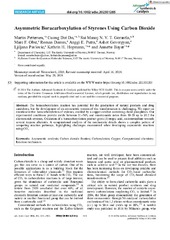Browsing by Author "Do, Cuong Dat"
-
Asymmetric Boracarboxylation of Styrenes Using Carbon Dioxide
Pettersen, Martin; Do, Cuong Dat; Gorantla, Sai Manoj N. V. T.; Obst, Marc; Damm, Roman; Putra, Anggi Eka; Gevorgyan, Ashot; Pavlovic, Ljiljana; Hopmann, Kathrin Helen; Bayer, Annette (Journal article; Tidsskriftartikkel; Peer reviewed, 2024-04-22)The boracarboxylation reaction has potential for the production of natural products and drug candidates, but the development of an asymmetric version of this transformation is challenging. We report an enantioselective boracarboxylation of styrenes, enabled by a copper catalyst containing chiral phosphines. Our experimental conditions provide yields between 31–76% and enantiomeric ratios from ... -
Room Temperature-Stable Magnesium Electride via Ni(II) Reduction
Do, Cuong Dat; Day, Craig S.; Odena, Carlota; Benet-Buchholz, Jordi; Xu, Liang; Foroutan-Nejad, Cina; Hopmann, Kathrin Helen; Martin, Ruben (Journal article; Tidsskriftartikkel; Peer reviewed, 2022-07-13)Herein, we report the synthesis of highly reduced bipyridyl magnesium complexes and the first example of a stable organic magnesium electride supported by quantum mechanical computations and X-ray diffraction. These complexes serve as unconventional homogeneous reductants due to their high solubility, modular redox potentials, and formation of insoluble, non-coordinating byproducts. The applicability ... -
Room-Temperature-Stable Magnesium Electride via Ni(II) Reduction
Day, Craig S.; Do, Cuong Dat; Odena, Carlota; Benet-Buchholz, Jordi; Xu, Liang; Foroutan-Nejad, Cina; Hopmann, Kathrin Helen; Martin, Ruben (Journal article; Tidsskriftartikkel; Peer reviewed, 2022-07-13)Herein, we report the synthesis of highly reduced bipyridyl magnesium complexes and the first example of a stable organic magnesium electride supported by quantum mechanical computations and X-ray diffraction. These complexes serve as unconventional homogeneous reductants due to their high solubility, modular redox potentials, and formation of insoluble, noncoordinating byproducts. The applicability ... -
Titanium isopropoxide-mediated cis-selective synthesis of 3,4-substituted butyrolactones from CO2
Sahari, Aleksi; Do, Cuong Dat; Mannisto, Jere K.; Antico, Emanuele; Amaratunga, Angelo; Hopmann, Kathrin Helen; Repo, Timo (Journal article; Tidsskriftartikkel; Peer reviewed, 2022-02-14)We report a Ti(OiPr)4-mediated multicomponent reaction, which produces 3,4-substituted cis-d-lactones from alkyl magnesium chloride, benzaldehyde and CO<sub>2</sub>. The key intermediate, titanacyclopropane, is formed in situ from Ti(OiPr)4 and a Grignard reagent, which enables 1,2-dinucleophilic reactivity that is used to insert carbon dioxide and an aldehyde. An alternative reaction route ...


 English
English norsk
norsk


